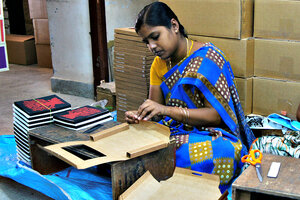Tara Books opens a new page for tribal artists in India
Gita Wolf collaborates with India's women tribal artists to create award-winning books and help the women step across the gulf that divides them from the modern world.

A woman works in the print shop at Tara Books in Chennai, India.
Courtesy of Stell Simonton
Chennai, India
Goats wander along a dusty street in this south Indian city once known as Madras. Around a corner, down an alley and away from the rushing trucks, bicycles, and motorized rickshaws, is a small, gleaming glass-walled building lined inside with bookshelves.
It’s the home of Tara Books, created by visionary publisher Gita Wolf. Over the past 10 years, she has collaborated with women tribal artists to create award-winning publications. In doing so, she’s helped the women step across the gulf that divides preliterate societies from the modern world of arts and letters.
For example, flowing white designs from the mud-walled huts of the Meena tribe in Rajasthan tell the story of a wily jackal in the book “Gobble You Up!”
Women of the tribe originally painted intricate pictures in lime on the brown walls and floors of their homes. The art rarely had been seen outside villages because the designs were short-lived and the women stayed close to home.
Artist Sunita (who uses only one name) learned the practice from her mother and sister and worked with Ms. Wolf to tell a story on paper. The resulting children’s book designed by Rathna Ramanathan was published in 2013 and won a Blue Elephant from the Kyoorius Design Awards.
“We are the first to have brought these art forms into books,” Wolf says.
Books about tribal art exist, but the artists had not moved into creating their own books.
“Before us, no one had used them as artists to tell their own story,” Wolf says.
Tara sponsors workshops and invites artists who come from very different backgrounds than the urban middle class of India.
After attending a workshop, Amrita Das began creating images that became illustrations for her book “Hope is a Girl Selling Fruit.”
Ms. Das paints in the Mithila tradition developed in the state of Bihar, where shamanic symbols and traditional patterns adorn walls and floors, particularly for weddings and festivals. Many of the images have specific meanings — a lotus symbolizes prosperity and a parakeet means fertility, Wolf says.
Das put images of luxuriant foliage, birds, and rich domestic details in rose, green, and yellow onto paper. She wanted to tell her own story, which Wolf and Susheela Varadarajan translated from Hindi. In her illustrations, she pushed the boundary of the traditional style.
“Amrita used many symbols with common meaning and also invented a lot,” Wolf says.
In the resulting book, the narrator sees a poor girl taking an overnight train from a rural village into Chennai. She fears for the girl, whose experience of village life could leave her unprepared for a modern city.
The girl could be one of the millions of people from rural areas around the globe, standing at the threshold of a technologically driven modern world. As they step across the gap, they come face to face with confusion, exploitation, and even simple loneliness. In her quiet voice, Das addresses this enormous global issue.
But the narrator finds hope in an unexpected place: She sees a young fruit-seller in torn clothes pushing a cart — and she learns something in the encounter.
In the book’s preface, Das says she herself started out not knowing much, “certainly not about the outside world.
“And then it came my way, that sliver of a chance which has made it possible for me to do this book,” she wrote.
Wolf and others at Tara brought the opportunity to Das. They say different voices bring richness to Tara’s work.
“We wanted to create the opportunity for stories to be truly told from another point of view,” Wolf says. “We’re tapping into lots that is local – not bland global” but that also has universal themes.
Many folk artists in India don’t read and write, Wolf says. But they respect books. And book royalties allow them to receive continuing payments in contrast to the one-time payment for a single painting.
Wolf was born in India, married a German man, and taught comparative literature in Germany. Unhappy in that pursuit, she moved back to south India in 1994. She had a young son and was dissatisfied with the available children’s books. She wanted to see bold illustrations that showed children the world of India, and she enlisted friends who were writers and designers to help create them.
She was also active in the feminist and anti-caste movements. Five years ago she turned Tara into a worker-owned collective.
At Tara “we gravitate toward reversing entrenched power,” she says. “Art brings out the complexity in people’s lives.” It doesn’t present people as numbers or problems. It allows for a much wider exploration of humanity, she says.
Art is needed to do what politics cannot, Wolf argues. In creating a book about Martin Luther King Jr., Tara Books paired a scroll maker from the Patua tradition in India with a Mississippi Delta storyteller, Arthur Flowers.
A new Tara Book coming this year employs the work of a painter and toymaker from Oaxaca, Mexico, to produce the title “Marcelo’s Toys.”
Tara Books has also created an exhibit about tribal women’s domestic art that will travel to Paris in November.
Wolf's vision continues to expand as Tara Books works with artists and writers to create beautiful books for both children and adults that show the power of design to captivate and explore new truths.
• For more about Tara Books visit http://www.tarabooks.com.


